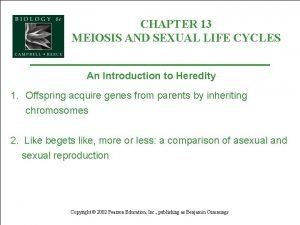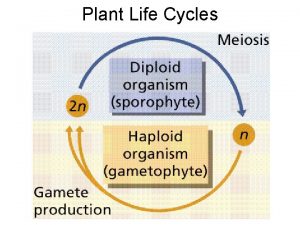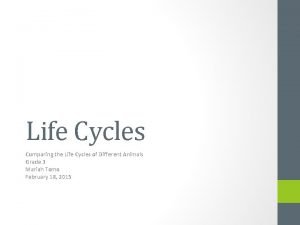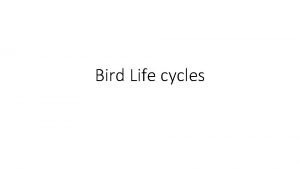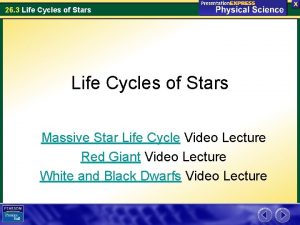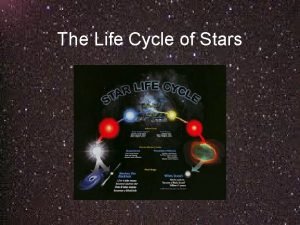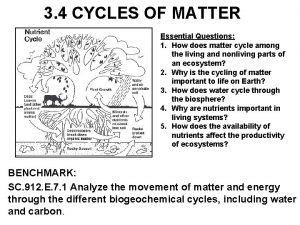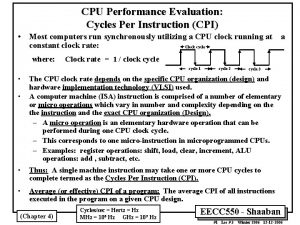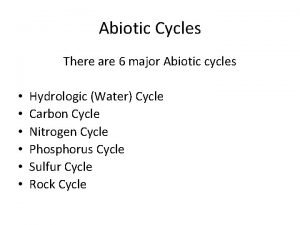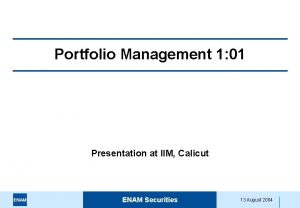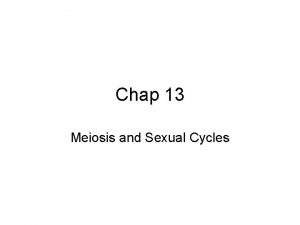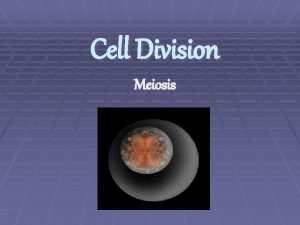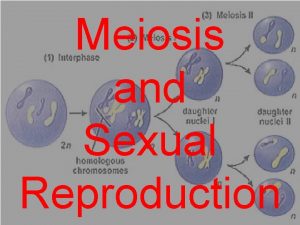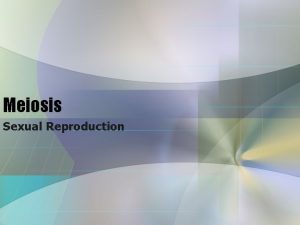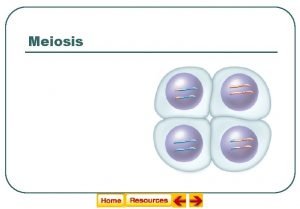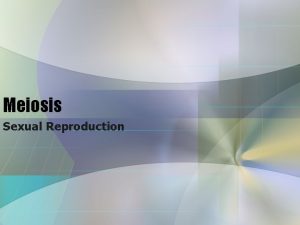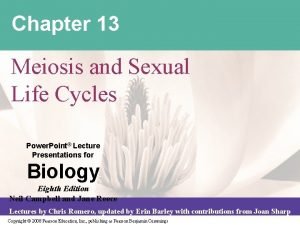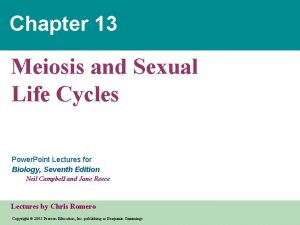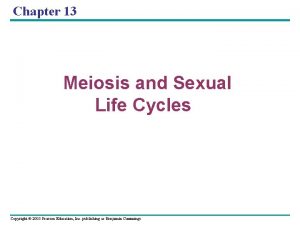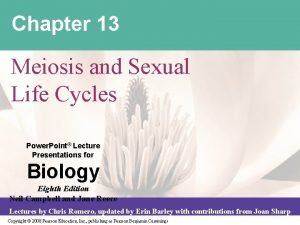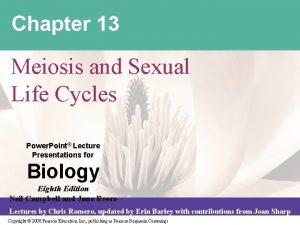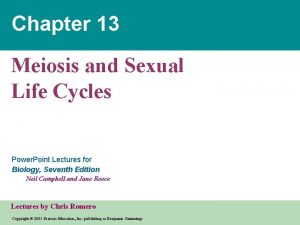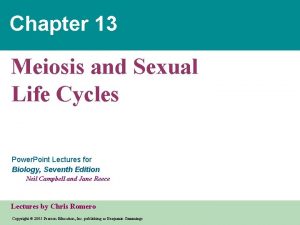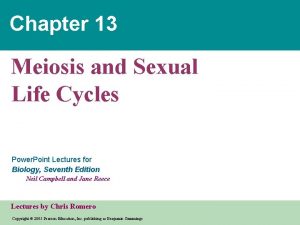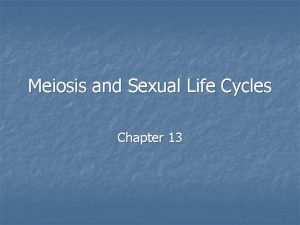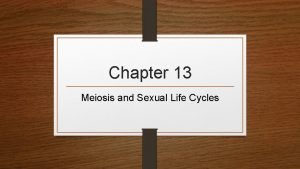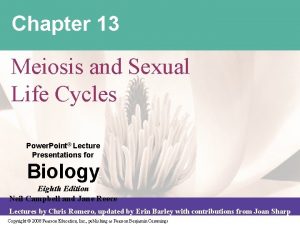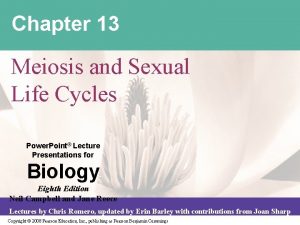Chapter 13 Meiosis and Sexual Life Cycles Life









































- Slides: 41

Chapter 13 Meiosis and Sexual Life Cycles

Life Cycle: Span of time from one generation to the next. This Chapter deals with how one generation produces the next generation for animals with a sexual life cycle. A. Somatic cells include all cells other than egg and sperm cells. Each normal somatic cell in humans has 46 chromosomes. (The cell cycle discussed in Chapter 12 was for somatic cells. ) - The 46 chromosomes = 23 pairs of homologous chromosomes. - The same genes are carried on each homologous chromosome. - The exceptions are the XX chromosomes in females (homologous), and the XY chromosomes in males (partly homologous). Y has genes that are not present on X. The X and Y chromosomes are called sex chromosomes. The other chromosomes are called autosomes.





B. The other human cells that are not somatic cells are called gametes. There are two types of gametes. Males have sperm cells and females have egg cells. - A sperm cell has 22 autosomes plus either one Y or one X chromosome (the sex chromosome). - An egg cell has 22 autosomes plus one X chromosome (the sex chromosome). - Because gametes contain only one set of chromosomes, they are said to be haploid; the number of chromosomes is referred to as 1 n = 23 (n = one set of chromosomes) - Somatic cells contain duplicate sets of chromosomes, and are said to be diploid; the number of chromosomes is referred to as 2 n = 46

- Diploidy (where 2 n = 46) arises when a sperm cell fertilizes an egg cell. A fertilized egg is called a zygote. 1 n (♀) + 1 n (♂) = 2 n - The zygote grows and the cell divides again and again to create the mature adult. All somatic cells undergo mitosis for this process (See Chapter 12). - Eventually, the adult will form either sperm or eggs (which are 1 n); and the process starts over again. - The process by which haploid cells are produced is called meiosis. Note: if somatic cells did not undergo meiosis in producing sperm and egg cells, the next generation would contain double the number of chromosomes in a somatic cell (4 n). Thus, meiosis is a vital process in reproduction to keep the chromosome number correct! Please memorize Figure 13. 5 (p. 241) – The human life cycle.


The process in Figure 13. 5 is the human life cycle; it depends on sexual reproduction. Why do most animals use sexual reproduction? There are certain advantages: Genes from two parents are both present in the offspring; this allows for trying out different sets of genes to see which combination works best. If one gene is mutated and of no value to the offspring, there is a second gene from the other parent that can often be used to offset the “bad” gene. For this reason, sexual reproduction is common in higher organisms where generations alternate between 1 n and 2 n.

In Figure 13. 6 you can see how sexual reproduction occurs for three different groups of organisms note the alternation of generations between 1 n and 2 n! By contrast, some organisms reproduce asexually - Film showing “Budding” by hydra. à Note that for each life cycle, the constant theme is that meiosis reduces the number of chromosomes in the gametes to 1 n. Fertilization then produces a 2 n zygote.


C. Meiosis – Purpose is to reduce the chromosome number from diploid (2 n) to haploid (1 n) in the gametes. In Meiosis there are three stages: Replication of chromosomes during Interphase, then Meiosis I (homologous chromosomes separate), then Meiosis II (sister chromatids separate). The basic outline of the process of meiosis is given in Figure 13. 7 (p. 243) – Overview of meiosis: how meiosis reduces chromosome number. Note where split between 2 n and 1 n occurs. Note that the haploid cells are the sperm and ovum. One somatic cell gives rise to either four sperm or four ova.


- The Sexual Life Cycle of a cell can be divided into phases: 1. Interphase (Same as in mitosis) Meiosis I: 2. Prophase I 3. Metaphase I 4. Anaphase I 5. Telophase I and Cytokinesis Meiosis II: 6. Prophase II 7. Metaphase II 8. Anaphase II 9. Telophase II and Cytokinesis You need to memorize Figure 13. 8 and all details associated with the stages of meiotic cell division.


1. Interphase - Chromosomes are replicated similar to interphase in mitosis - Centrosomes also replicate


2. Prophase I Main goal is to rearrange the chromosomes by swapping segments between sister (homologous) chromosomes. Reason? To create new combinations of genes to create offspring that have some variability. This will be very important in the Chapter on Mendelian genetics! - Chromosomes condense -Homologous chromosomes pair up – process is called synapsis (two sister chromatids are present for each homologous chromosome) - Clusters of four chromatids, called tetrads, become visible - Chromatids criss-cross at various places. These sites of crossings are called chiasmata. So at the chiasmata, segments of chromatids are swapped. - Spindle begins to form; microtubules attach to kinetochore - 90% of meiosis is spent in Prophase I


3. Metaphase I - Homologous pairs of chromosomes align at the metaphase plate (**Note that during mitosis, chromosomes are not paired during alignment) - Chromosomes are attached to centrosomes by microtubules


4. Anaphase I - Homologous chromosomes separate (sister chromatids remain attached) - Note that chromosomal rearrangement has occurred due to criss-crossing – This is evident in Figure 13. 8 but not in the following short movie.


5. Telophase I and Cytokinesis - Cleavage furrow becomes apparent - Division of cytoplasm results in two (2) haploid cells (1 n = 23). Note: These are haploid cells with two sister chromatids. Review Figure 13. 8 (p. 244) – we are presently where Meiosis 1 stops.




We now need to split apart the sister chromatids and this will happen in Meiosis II.


6. Prophase II - Spindle begins to form 7. Metaphase II - Chromosomes align at the metaphase plate - Kinetochores attach to microtubules leading to centrioles 8. Anaphase II - Sister chromatids separate - Chromosomes are pulled to opposite ends of the cell 9. Telophase II and Cytokinesis - Nuclei form around chromosomes - Cytoplasm divides to form two (2) cells Then end result is: From one cell we have created four (4) haploid (1 n) daughter cells with unreplicated chromosomes


Figure 13. 9 (p. 246) – A comparison of mitosis and meiosis. Note 2 n and 1 n designations of the cells!


D. Outcome of Sexual Reproduction Genetic Variation Among Offspring that occurs in three ways. 1. Independent assortment - Positioning of homologous chromosomes occurs by chance Figure 13. 10 (p. 248) – The results of alternative arrangements of two homologous chromosome pairs on the metaphase plate in meiosis I.


2. Crossing over - Results in the production of recombinant chromosomes. Recombinant chromosomes form when DNA from two parents occurs on the same chromosome. This occurs during cross-over. - Figure 13. 11 (p. 249) – The results of crossing over during meiosis.



3. Random fertilization - There are 8 million possible chromosome combinations, using 46 chromosomes, when producing egg and sperm cells. - Egg x Sperm = 64 Trillion combinations

 Chapter 13 meiosis and sexual life cycles
Chapter 13 meiosis and sexual life cycles Chapter 13 meiosis and sexual life cycles
Chapter 13 meiosis and sexual life cycles Crossing over occurs during
Crossing over occurs during Chapter 10 meiosis 1 and meiosis 2
Chapter 10 meiosis 1 and meiosis 2 Chapter 10 section 1: meiosis
Chapter 10 section 1: meiosis Sexual reproduction and genetics section 1 meiosis
Sexual reproduction and genetics section 1 meiosis Sexual reproduction and genetics section 1 meiosis
Sexual reproduction and genetics section 1 meiosis Difference between meiosis 1 and meiosis 2
Difference between meiosis 1 and meiosis 2 Fadlife
Fadlife Plant life cycles and alternation of generations
Plant life cycles and alternation of generations Disvantages of sexual reproduction
Disvantages of sexual reproduction Meiosis 1
Meiosis 1 Meiosis 1
Meiosis 1 Cycle.of life
Cycle.of life Rvguev
Rvguev Life cycles of a bird
Life cycles of a bird Life cycle of a star assessment
Life cycle of a star assessment Life cycle of a star
Life cycle of a star Xenospore
Xenospore 4 cycles of matter
4 cycles of matter Compare and contrast carbon and nitrogen cycles
Compare and contrast carbon and nitrogen cycles Pedigree miscarriage symbol
Pedigree miscarriage symbol Chapter 10 sexual reproduction and genetics
Chapter 10 sexual reproduction and genetics John ehlers
John ehlers Chapter 20 sexual reproduction in animals packet answers
Chapter 20 sexual reproduction in animals packet answers Mandarin cycles
Mandarin cycles Importance of water cycle
Importance of water cycle Pdsa cycles
Pdsa cycles Precession milankovitch cycles
Precession milankovitch cycles Transaction cycle flow chart
Transaction cycle flow chart Cpi cycles per instruction
Cpi cycles per instruction Biogeochemical cycles performance task
Biogeochemical cycles performance task Biogeochemical cycles apes
Biogeochemical cycles apes Abiotic cycles
Abiotic cycles Biogeochemical cycle quiz
Biogeochemical cycle quiz Enam securities portfolio
Enam securities portfolio Joke cycles
Joke cycles Joke cycles
Joke cycles Biogeochemical cycles class 9 ppt
Biogeochemical cycles class 9 ppt Sleep wake cycle
Sleep wake cycle Cell cycle foldable project
Cell cycle foldable project Design science research cycles
Design science research cycles

